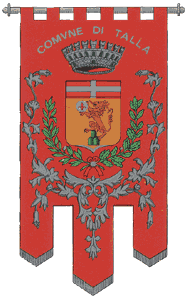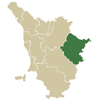|
 Abitanti nel 1991: 1.237
Abitanti nel 1991: 1.237
 The Municipal territory of Talla, in the Valdarno Casentinese,
occupies an area of 60.18 square kilometres which reach from the south
eastern slopes of the ridge of Pratomagno to the low hills which slope
down towards the right bank of the Arno. It was inhabited in Etruscan
times, a feudal centre, it reached its present day aspect in 1809
with the creation of the “mairies” : the community of
Castel Focognano was deprived of a part of its territory (comprising the
districts of Talla, Bagnena, Bagno, Bicciano, Pieve, Pontenano, Capraia,
Faltona and Campovecchio) which formed the new community of Talla.
The Municipal territory of Talla, in the Valdarno Casentinese,
occupies an area of 60.18 square kilometres which reach from the south
eastern slopes of the ridge of Pratomagno to the low hills which slope
down towards the right bank of the Arno. It was inhabited in Etruscan
times, a feudal centre, it reached its present day aspect in 1809
with the creation of the “mairies” : the community of
Castel Focognano was deprived of a part of its territory (comprising the
districts of Talla, Bagnena, Bagno, Bicciano, Pieve, Pontenano, Capraia,
Faltona and Campovecchio) which formed the new community of Talla.
Talla is certainly of Etruscan origin (confirmed by the discovery in 1888
of a necropolis), it was recorded for the first time in 1057 in a document
stipulated by a certain Ugo del fu Grifo and his son Ardingo “in
castro Talla”. It seems in fact that before passing under
the Lordship of the Ubertini di Chitignano in 1249, the Castle
of Talla was probably dominated by a branch of a local lineage
the Ardinghi di Catenaia. In 1314 it became part of the possessions
of the Tarlati and at the death of Bishop Guido it again returned
under the Ubertini, who, however, in 1353 obliged it to submit to the
sovereignty of the Firenze republic, who conquered Talla definitively
with all the district of Arezzo
in 1384. The Castle with its territory was then aggregated to the
Podesta office of Castel Focognano. Talla claims the merit of having given
birth to Guido di Arezzo,
better known as Guido Monaco, inventor of the modern system of
musical notation (997-1050ca.). During the last war most of the township
was burnt down in July 1944.
Places to Visit :
Parish church of San Niccolò with the astonishing decorations
on the ancient organ frame.
Piazzetta Landi, with its characteristic colonnades and with
the Monument to the Fallen by Domenico Purificato. |
Historical info reproduced upon authorization of Regione Toscana - Dipartimento della Presidenza E Affari Legislativi e Giuridici
Translated by Ann Mountford
|